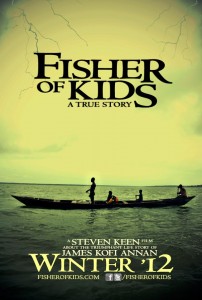CHILD LABOR AND ENSLAVEMENT IN GHANA’S LAKE VOLTA FISHING INDUSTRY
By Sharon L. Fawcett, CLC Intern
For a small sum of money, James Kofi Annan’s father handed him over to a child trafficker when he was just six years old. Born into a family in Ghana with 12 children, there was no money for school uniforms and books. So instead of gaining an academic education, James would learn the painful lessons of the enslaved, in Ghana’s fishing villages.
Sold by his trafficker to a Lake Volta fisherman, James worked 17 hours per day, enduring constant physical and emotional abuse. When displeased, his master often withheld food, beat him with a paddle, or threw him in the lake.
Lake Volta, one of the world’s largest man-made lakes, was created by the construction of Ghana’s Askombo dam in the 1960s. Although the lake provided a bountiful supply of fish for many years, fish stocks have been declining in recent years, making it more difficult for fishermen to earn a living. Children provide a cheap source of labor and their tiny fingers prove useful for picking the fish that are captured in the nets’ webbing, as the holes get increasingly smaller to catch smaller fish.
The children trafficked to work in Ghana’s fishing industry as bonded laborers are as young as four years of age. Their tasks may include paddling boats, hauling nets, or performing domestic labor in the homes of fishermen. Like James Kofi Annan, these children work long hours for no pay; do not attend school; and are often malnourished, sleep deprived, and treated abusively. Nets often get snagged on submerged tree branches and children forced to dive underwater to free them risk water-borne diseases and drowning.
According to the United Nation’s Food and Agriculture Organization (FAO) and the International Labor Organization (ILO), 60 percent of the world’s 215 million child laborers work in the agricultural sector—comprising activities in agriculture, livestock-raising, forestry, and fishing. In Ghana, one in six children aged six to 14 are involved in child labor. Eighty-eight percent of them work on farms; another 2.3 percent in fishing.
Work that is likely to harm the health, safety, or morals of children is categorized as hazardous by the ILO. This is the kind of work Lake Volta’s child fishers are exposed to, among the “worst forms of child labor.”
Ghana has ratified several international conventions that establish standards to protect children from exploitative work, including the ILO’s Minimum Age Convention (C138) and the Worst Forms of Child Labor Convention (C182). It also has national laws restricting child labor, but the laws are not vigorously enforced. The minimum age for work in Ghana is 15 years; 18 years for hazardous work. However, the practice of children working is commonly accepted in Ghanaian society.



